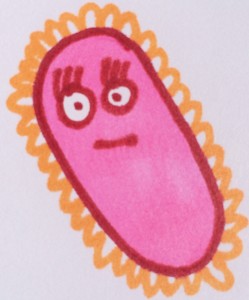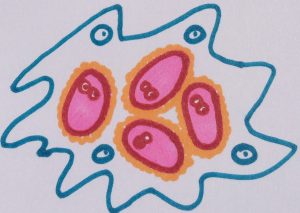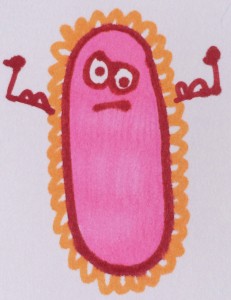Haemophilus influenzae type b (Hib) vaccine

I once heard someone say that when you sneeze, droplets of saliva fly through the air and can land five feet away.Five feet!? Yuck! I’m not sure EXACTLY how far those droplets are carried through the air, but what I am sure of is that within those droplets are potentially millions of viral particles and thousands of bacterial cells.
One nasty bacteria in particular, called Haemophilus influenza (H. influenza), may be living in your nose and throat at all times and you do not even know it. In fact, you may not have ever come down with the illness and still have it in your body. And unfortunately, should someone who has it cough or sneeze and your child inhales the particles, it has the potential to make your child life-threateningly ill.
H. influenza, not to be confused with the influenza virus that causes the “flu”, is responsible for serious childhood illness. There are several types, or strains of H. influenza, however H. influenza type b (Hib) tends to be the culprit that can land your child in the hospital.

Once Hib enters your child’s body, it takes on a life of its own. Commonly, it will cause ear and throat infections, which your child has the chance to overcome with antibiotics, however many Hib infections in children under the age of five become severe.
These are common invasive illnesses caused by Hib:Severe infections occur when the Hib bacteria invade parts of the body that are normally free from germs; when this happens, the disease is called “invasive”. Unfortunately, many invasive infections caused by Hib can result in death.
1. Meningitis: An infection of the covering of the brain and spinal cord.
- The symptoms of meningitis include:
- Fever
- Headache
- Stiff neck
- Nausea
- Vomiting
- Sensitivity to light
- Confusion
- Very serious and causes death in 1 out of 20 children.1
- 10-30% of children that survive meningitis have permanent brain damage.1
- Infants that get meningitis appear to be limp and lose their sense of alertness. They usually will eat less, may be vomiting, and have poor reflexes.
2. Epiglottitis: A life-threatening infection of the throat.
3. Pneumonia: Occurs when the lungs become infected and swell. Symptoms of pneumonia usually include:
- Fever
- Cough
- Shortness of breath
- Chills
- Sweating
- Chest pain that comes and goes with breathing
- Headache
- Muscle pain
- Excessive tiredness
4. Bacteremia: An infection of the blood. It can cause symptoms such as:
- Fever
- Chills
- Excessive tiredness
- Pain in the belly
- Nausea
- Vomiting
- Diarrhea
- Anxiety
- Shortness of breath
- Confusion
5. Cellulitis: An infection of the skin.
6. Arthritis: An infection of the joints.
7. Osteomyelitis: An infection of the bone.
If your child should come down with a mild case of Hib, your doctor will treat him with antibiotics that last for ten days. However, even when given proper antibiotics somewhere between 3% and 6% of children with Hib still die from it. And in the case of an invasive disease, your child will need to be hospitalized.
Along with children under five, your child may have an even higher risk of contracting Hib if he is American Indian or an Alaska Native. Also, if your child has a medical condition such as sickle cell anemia, if he has had his spleen removed or damaged, has HIV/AIDS or another immune system disease, is being treated with drugs such as steroids, has an antibody or complement deficiency syndrome, has had a bone marrow or organ transplant, or is getting cancer treatment with x-rays or drugs, he has an even higher chance of contracting Hib.
The Hib vaccine is highly recommended for the special risk groups above, as well as for all young children because it will protect them from getting invasive infection should they happen to pick up the Hib bacteria.
The CDC recommends Hib as part of your child’s vaccine regimen. Your baby will be given one of two types of Hib vaccines based on your child’s vaccine requirements. And the great thing about these combination vaccines is that your child is given two or three vaccines in one single shot, instead of multiple shots.
Here are the two vaccine types:
1. PRP-T, which contains ActHIB® and Pentacel®. A combined vaccine with DTap (diphtheria, tetanus, and pertussis vaccine), IPV (inactivated polio vaccine), and Hib.
- Given in 3 does at 2, 4, and 6 months of age.
2. PRP-OMP, which contains PedvaxHIB® and Comvax®. The vaccine contains Hib and the Hepatitis B vaccine.
- Given in 2 doses at 2 and 4 months of age.
No matter what vaccine your child gets, all children need a booster shot between 12 and 15 months of age.
Before we had a Hib vaccine, the most common type of invasive Hib disease was meningitis. In fact, Hib was the number one cause of bacterial meningitis in children younger than 5 years of age.1 Now that the vaccine exists, the most common invasive disease children get if they ARE NOT vaccinated is pneumonia.
If your child has not gotten the vaccination, but has had Hib, their body may not have developed the protective memory antibodies that it needs to fight off the bacteria again like it would have gotten with the vaccine. In that case, your child would be susceptible to infection with Hib again. Therefore, children younger than 24 months of age who have recovered from invasive Hib disease should not be considered protected and should receive Hib vaccine as soon as possible.1

Your child should not get the Hib vaccine’s following doses if he has been vaccinated with the first dose and had a severe allergic reaction to it. Also, your child shouldn’t be vaccinated if he is under 6 weeks old or if he is ill at the time of getting the vaccine. If your child is sick when scheduled to get the vaccine, just wait until he is better so that his immune system has the best chance of making memory antibodies to fight the bacteria. Also, there is little risk of your child developing a serious infection of Hib after the age of five, so if your child is older than five, the vaccine is not recommended.
If your child misses a dose or gets behind in the vaccine schedule, get the next dose as soon as you can. There is no need to start over.
Your child may be getting multiple vaccines at each visit, so it’s important to know that studies show that Hib is perfectly safe to be given at the same time as other vaccines.1
The side effects to the Hib vaccine are minimal, and the risk of serious harm is very small. There are several mild side effects that have been reported. According to the CDC within two weeks of getting the vaccine your child may have these side effects:
- headaches, upper respiratory tract infection (1 out of 3 children)
- stuffy nose, sore throat, joint pain (1 out of 6 children)
- abdominal pain, cough, nausea (1 out of 7 children)
- diarrhea (1 out of 10 children)
- fever (1 out of 100 children)
More serious side effects are seen in about 1 out of 100 children within 6 months of vaccination, and include blood in the urine or stool, pneumonia, and inflammation of the stomach or intestines.1
What to do if your child has a serious reaction to a vaccine.
The chance that your child will have some mild side effects from the Hib vaccine are definitely a worry for most parents. You can assume that your child might be the one in three that ends up having a bit of a crappy day or two after getting the vaccine. However, the decision not to immunize your child with Hib is extremely risky. The high chance of serious illness in children under five is staggering. Your child having a runny nose for a few days holds no candle to your child spending a month in the ICU with meningitis or pneumonia.
This is not sickness to take lightly. Should you decide not to vaccinate your child against Hib, you are not only putting your child at risk, but putting other children who come in contact with him at risk of contracting a potentially deadly disease.
Resources:
- Centers for Disease Control and Prevention (CDC). www.cdc.org
- Vaccines.gov. www.vaccines.gov
Pictures are Vaccine Mom original artwork.

